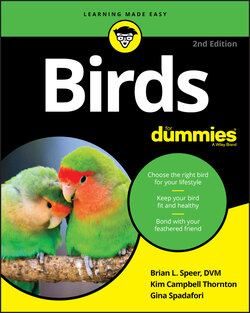Читать книгу Birds For Dummies - Gina Spadafori - Страница 94
PUTTING YOUR BIRD IN A TIME-OUT
ОглавлениеSome bird owners may benefit from the purchase of a smaller time-out cage for use when your bird is driving you crazy. (It happens in the best of families, believe us!) The cage doesn’t have to be elaborate — sturdy and just large enough to fit your bird comfortably, and portable enough to allow him to chill for a while — out of the traffic flow in the home. The time-out cage can also double as your bird’s travel cage, a sleeping cage, or an outside “shower cage,” when set beneath a fine mister outdoors.
If you’ve ever seen how happy birds are at a bird bath, it’ll come as no surprise to you that your pet bird will enjoy getting wet from time to time. And it’s good for her, too! For more on showers, see Chapter 7.
Although you never need a cage cover to keep your bird warm in a heated home, sometimes this tool is useful in handling an out-of-control bird. For more on the use of cage covers, see Chapter 12.
A small travel cage is fine, but so, too, are carriers designed for cats or small dogs (see the Figure 4-1), the kind made of high-impact plastic with vents on the side and a grid door on the front or top. For short trips, no perch is necessary — just put down a clean towel to give your bird solid footing. For longer trips or for your bird’s increased comfort even on short trips, however, fasten a perch dowel near the base of the carrier with two screws placed through the walls and into the ends of the perch.
Travel cages and carriers are important for reasons beyond the occasional trip to the veterinarian. In times of disaster, these transportable homes make it far easier to evacuate your pet and keep him safe until conditions improve.
Although you can carry a small bird in a paper bag, the benefits of owning and using a safe carrier far outweigh the modest price of acquiring one. Just as is commonly done with dogs and to some degree cats, birds can learn to enter their travel carriers on cue. (See Chapter 21 for more on carrier training.) This is an important skill to teach your bird. With the right training, he’ll enjoy going into his carrier and being rewarded for it, making it easier to take him to the vet or anywhere else he needs to go.
Carriers should have a large enough door for your bird to enter and exit comfortably. Cat carriers work well for small and medium-size birds and even some larger birds with short tails.
Add a perch for additional comfort. Even something as simple as a rope perch placed on the bottom of the carrier can increase your bird’s comfort inside the carrier.
Photograph courtesy of Melody Hennigh, Busy Beaks Academy (Oakley, California)
FIGURE 4-1: Many different types of carriers can be suitable for birds.
If your bird is likely to chew through a plastic carrier, look for an acrylic carrier with a perch already installed. Some models are long, which is useful for parrots with long tails, such as macaws. Wire dog crates, which come in many sizes and can easily support a perch, are another option. Wire crates may require additional locks or carabiners to prevent parrots from opening the doors and high-tailing it out of there.
Most birds appreciate having toys inside their travel carriers. Something they can shred and something they can hide inside or behind will make the carrier much more attractive to them.
